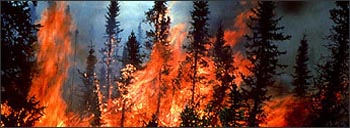Contributors: TK, Jeannie Allen

Through the Joint National Park Service (NPS)-USGS National Burn Severity Mapping Project, researchers use Landsat imagery to quantify fire effects over large, often remote regions and long time intervals. The project focuses on NPS Units and adjoining lands throughout the U.S. It combines the processing, data archive, and remote sensing expertise of the USGS Center for Earth Resources Observation and Science (EROS) with the local knowledge and field sampling capability of the NPS, and the fire-effects research of the USGS Northern Rocky Mountain Science Center.
The process uses Landsat 30-meter data and a derived radiometric value called the Normalized Burn Ratio. Researchers compute the difference between pre-and post-fire Normalized Burn Ratio datasets to determine the extent and degree of landscape change resulting from fire. Depending upon timing of post-fire acquisitions and use of similar phenology in scene pairs, the differenced Normalized Burn Ratio can be correlated with field observations to produce maps of ecological burn severity. Results are appropriate for a landscape perspective of whole burns, revealing their spatial heterogeneity and how fires interact with vegetation and topography at moderate scale and resolution.
For more in depth information visit the National Park Service (NPS)-USGS National Burn Severity Mapping Project website.

Be Part of What’s Next: Emerging Applications of Landsat at AGU24
Anyone making innovative use of Landsat data to meet societal needs today and during coming decades is encouraged to submit and abstract for the upcoming “Emerging Science Applications of Landsat” session at AGU24.





